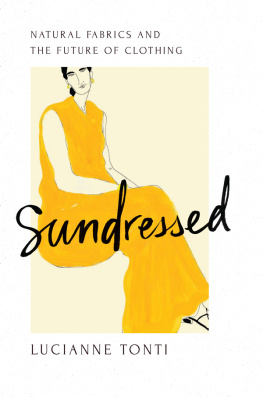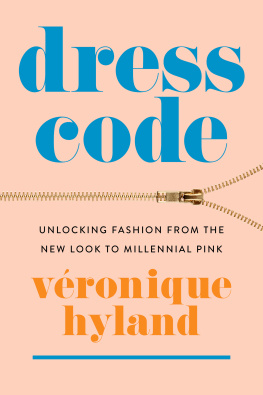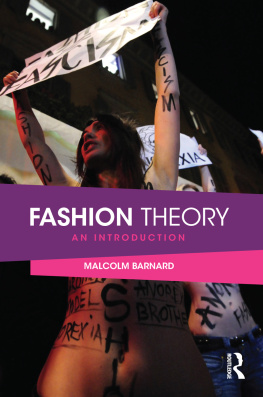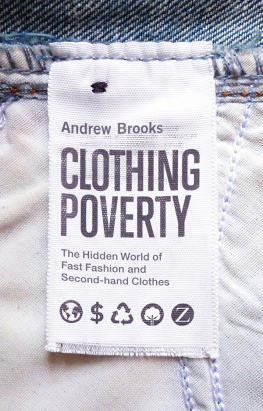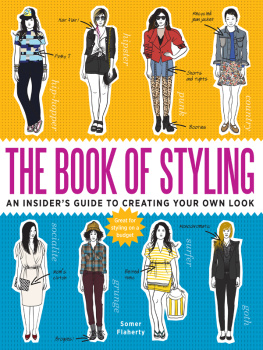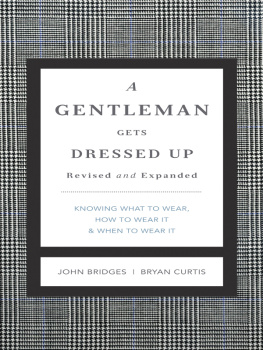Why Women Wear What They Wear
MATERIALIZING CULTURE
............................................
Series Editors: Paul Gilroy and Danny Miller
Barbara Bender, Stonehenge: Making Space
Gen Doy, Materializing Art History
Laura Rival (ed.), The Social Life of Trees: Anthropological Perspectives on Tree Symbolism
Victor Buchli, An Archaeology of Socialism
Marius Kwint, Christopher Breward and Jeremy Aynsley (eds), Material Memories:Design and Evocation
Penny Van Esterik, Materializing Thailand
Michael Bull, Sounding Out the City: Personal Stereos and the Management of Everyday Life
Anne Massey, Hollywood Beyond the Screen: Design and Material Culture
Wendy Joy Darby, Landscape and Identity: Geographies of Nation and Class in England
Joy Hendry, The Orient Strikes Back: A Global View of Cultural Display
Judy Attfield, Wild Things: The Material Culture of Everyday Life
Daniel Miller (ed.), Car Cultures
Elizabeth Edwards, Raw Histories: Photographs, Anthropology and Museums
David E. Sutton, Remembrance of Repasts: An Anthropology of Food and Memory
Eleana Yalouri, The Acropolis: Global Fame, Local Claim
Elizabeth Hallam and Jenny Hockey, Death, Memory and Material Culture
Sharon Macdonald, Behind the Scenes at the Science Museum
Elaine Lally, At Home With Computers
Susanne Kchler, Malanggan: Art, Memory and Sacrifice
Nicky Gregson and Louise Crewe, Second-Hand Cultures
Merl Storr, Latex and Lingerie
Lynn Meskell, Object Worlds in Ancient Egypt: Material Biographies Past and Present
Why Women Wear What They Wear
Sophie Woodward

English edition
First published in 2007 by
Berg
Editorial offices:
First Floor, Angel Court, 81 St Clements Street, Oxford, OX4 1AW, UK
175 Fifth Avenue, New York, NY 10010, USA
Sophie Woodward 2007
All rights reserved.
No part of this publication may be reproduced in any form
or by any means without the written permission of Berg.
Berg is the imprint of Oxford International Publishers Ltd.
Library of Congress Cataloging-in-Publication Data
Woodward, Sophie.
Why women wear what they wear / Sophie Woodward.
p. cm.
Includes bibliographical references.
eISBN: 978-1-84788-751-1
1. Clothing and dress. 2. Clothing and dressSocial aspects.
3. Clothing and dressPsychological aspects. I. Title.
TT507.W65 2007
646.34dc22
2007037812
British Library Cataloguing-in-Publication Data
A catalogue record for this book is available from the British Library.
Typeset by Apex Publishing, LLC, Madison, WI, USA.
Printed in the United Kingdom by Biddles Ltd, Kings Lynn
www.bergpublishers.com
For Kath and Steve
In memory of Sue Benson
Contents
This book owes a great deal to all of those who have supported me throughout the time it took to research and write. Because this book arose out of the ethnography for my PhD thesis, I would like to thank the Economic and Social Research Council for funding it; I am extremely grateful to Daniel Miller for his fantastic ideas and continued support throughout my research. I would also like to thank Joanne Entwistle and Emma Tarlo for useful comments on the original thesis, and those at Berg Publishers for their patience and help in turning the manuscript into a book.
I would especially like to thank my parents Kath and Steve for their constant belief in me; Kath, for her incredible insights and editing, and Steve, for his grasp of language and grammar. I would also like to remember Sue Benson, who died whilst I was writing this book but who was inspirational to me from the beginning. This book would also not have been possible without non-academic support, so thank-you to the rest of my family, Richard, Tamsin, Jack, Cleo and Eppy. For keeping me sane, thank-you to Bede, Joe, Paul, Philippa, Sarah, Cath, Zanna, Katy, Cristina, Colly, Craig, Emanuela and Vicky. For teaching me the fun side of academic life, I thank Dan, Rhoda, Shaila and Michelle.
Finally, and most importantly, I owe a debt of gratitude to all of the women who let me into their homes and bedrooms. Their participation made the fieldwork on which this book was based a pleasure to carry out, and it is because of their candidness in sharing their clothing triumphs and disasters with me that makes this book what it is.
Wearing only her pale pink silk camisole and shorts, Sadie gazes uninspired at the clothes in her open wardrobe; she is going to her friends leaving party the following day straight after work, and is attempting to select an outfit before she goes to bed. She stands in front of the wardrobe hoping her imagination will be roused by something she sees hanging before her. Ordinarily she selects her outfit just before going out, when the anticipation of the event galvanizes her into action. However, unsure as to what the weather will be like or what frame of mind she will be in the following day, she is unable to decide as her excitement is cast into shadow by the prospect of an eight-hour working day. She becomes despondent after a while and decides to select her shoes first, which she displays on a shelf in her bedroom. She tries on her favourite pair: pink ballet-style shoes with high metallic pink heels, which she only wears when she sporadically decides to try them on in her flat. She is so enthralled with the shoes that every outfit she has tried them on with before has failed to live up to their allure. Sadie is determined to wear them on this occasion, as she stands in front of the mirror, twisting her feet round so that they become visible from every angle, admiring the unusual shade of pink and the sculptural effect of the heels. Basking in the imagined admiration of her friends, she decides resolutely that she must wear the shoes.
She now has to resolve the problem of what to wear with them the following evening, and returns to the wardrobe. As she cannot afford anything new, she frantically looks along her rails for anything that will go with the shoes, and happens upon her cream cord mini-skirt. On trying it on with the shoes she is delighted at the complementarity of the colours. The skirt, being quite neutral, draws attention to the shoes. As the outfit is now two-thirds complete, she is determined not to be thwarted by a lack of a suitable top. As she goes through the piles of tops in the bottom of her wardrobe nothing seems appropriate. She clutches a pile of potentials in her arms, and holds each one in front of her body as she considers it: her cream top is too pale, making the top and skirt blend into one, and all her black, colourful or patterned tops are too dark for the outfit, drawing attention away from the shoes. In her frustration, she flings the clothes on the floor. She stands looking at shoes again in mirror; she is now wearing the cord skirt, and still happens to have her pale pink pyjama top on. On being confronted by her reflection, she makes the fortuitous realization that the whole outfit goes. She holds up her feet to examine the shoes, twisting them so they shimmer slightly: The tops the same colour as the shoes when they catch the light!! Sadie exclaims in delight. Initially unsure as to whether she can wear her nightwear on a night out in the West End of London, she decides no one will notice. She then chooses some underwear to go with the outfit, and ends up selecting a mint green bra with a pink trim: then therell be a flash of matching colours when the top of the bra peeps out at the top of the camisole.
Next page






![Woodward - State of Denial: Bush at War: [Part III]](/uploads/posts/book/211038/thumbs/woodward-state-of-denial-bush-at-war-part-iii.jpg)

